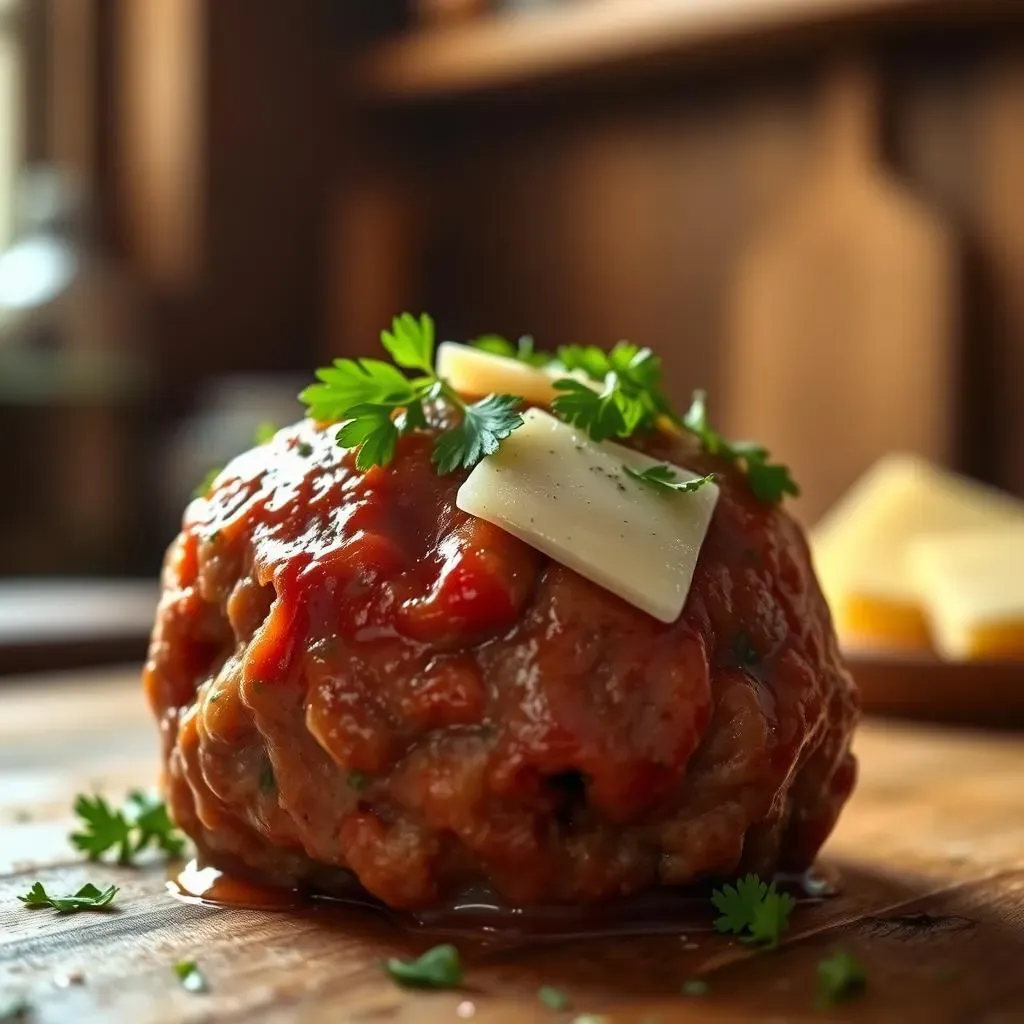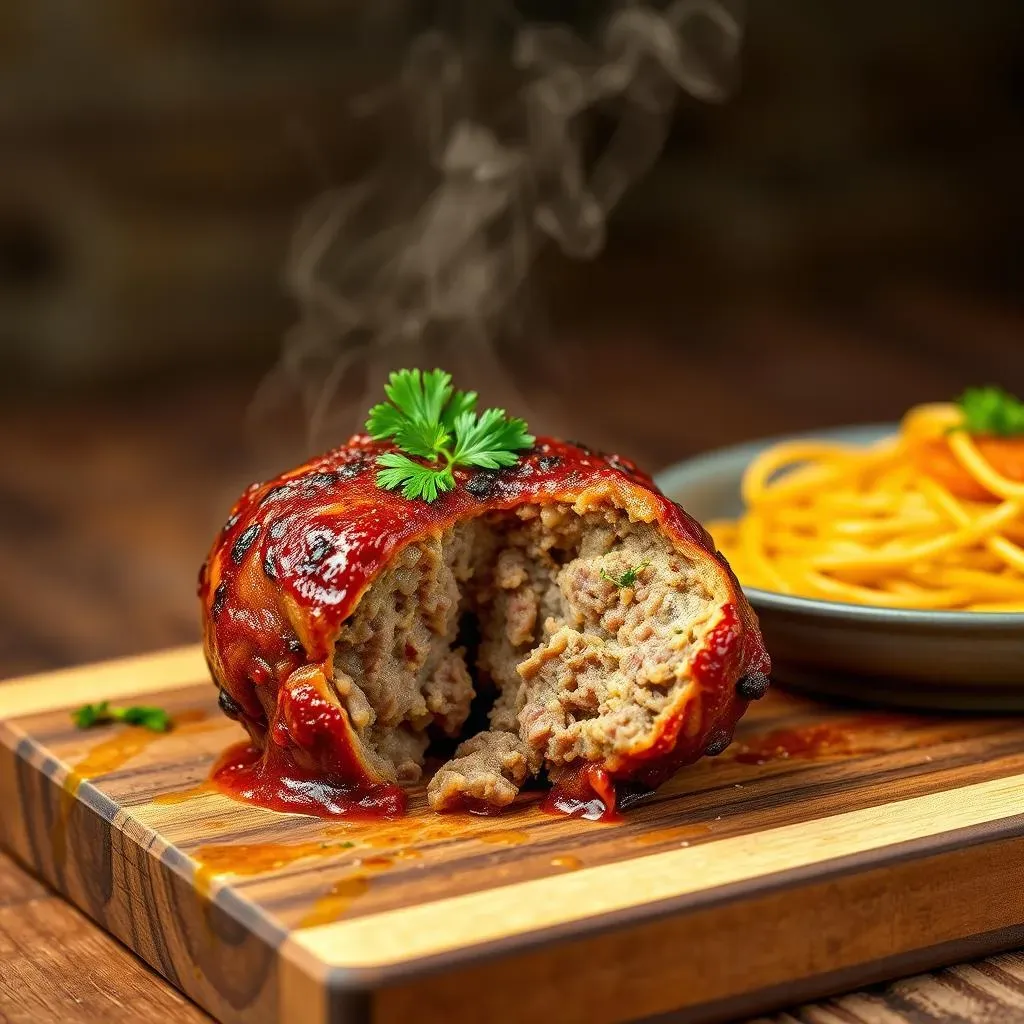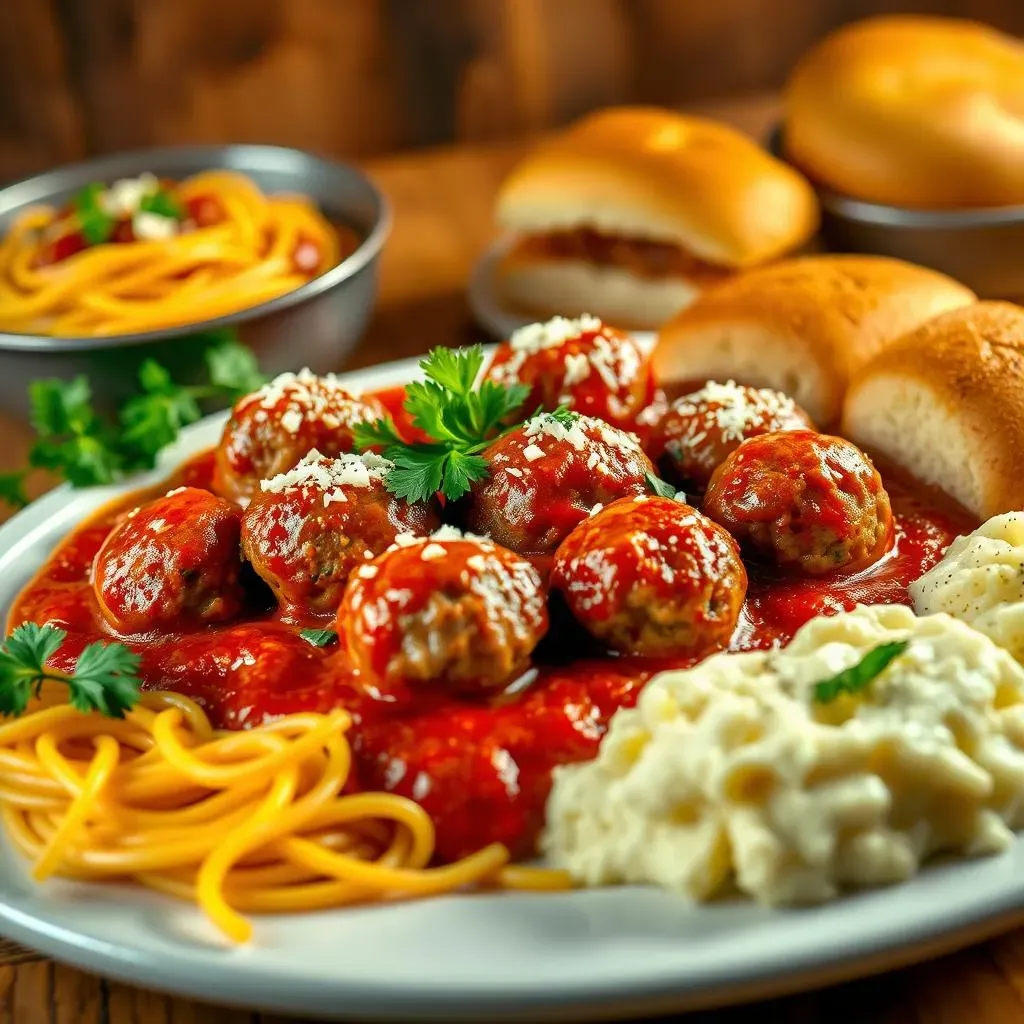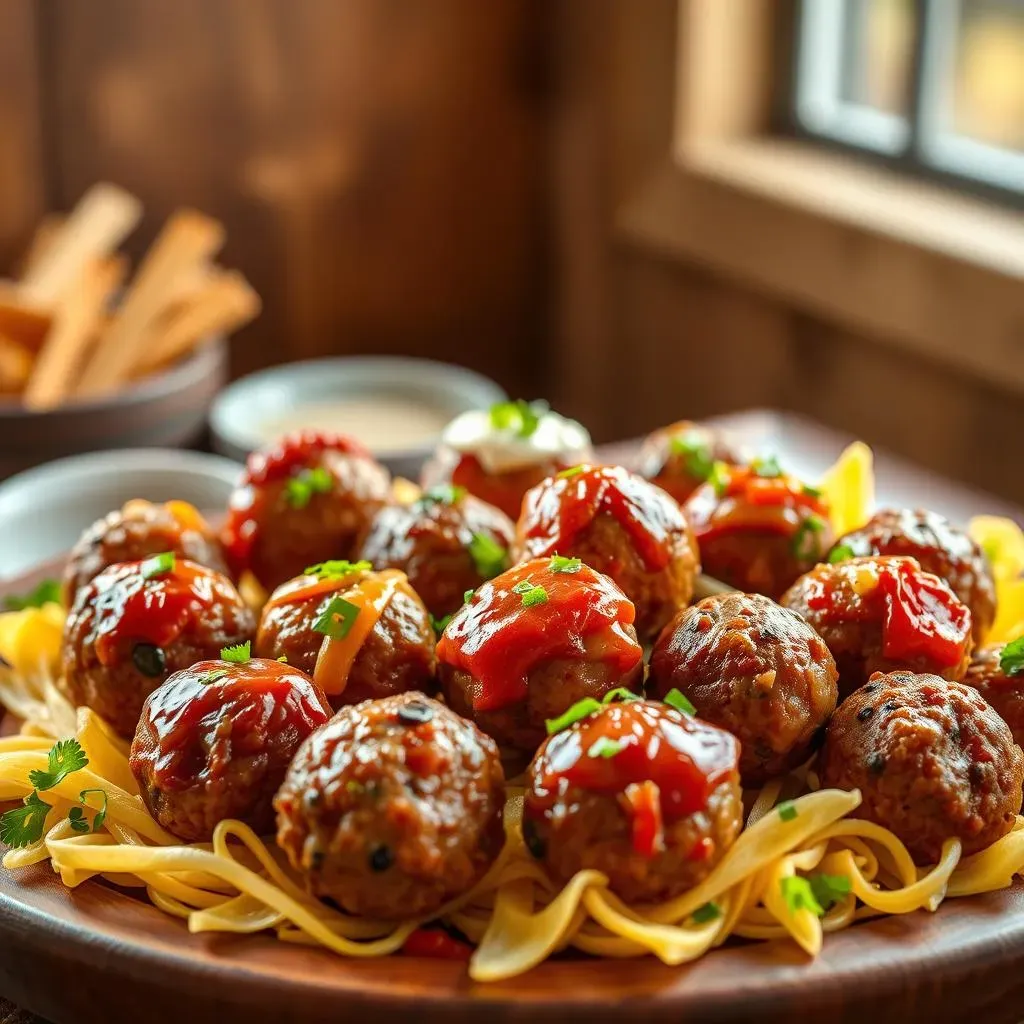Table of Contents
Ever dream of sinking your teeth into a plate of perfectly tender, flavor-packed meatballs? I know I have! Today, I'm sharing my go-to recipe for making the most amazing 2 lbs meatballs you've ever tasted. Forget those dry, bland hockey pucks you might have encountered, we're talking juicy, savory spheres of deliciousness that'll have everyone asking for seconds. This isn't just about throwing ingredients together; it's about understanding the science and art behind crafting the ideal meatball. We'll walk through each step, from selecting the right ingredients to mastering the cooking process. I'll even share some secrets to customizing your meatballs, so they're exactly how you like them. Get ready, because by the end of this article, you'll be a meatball maestro, confidently whipping up batches of 2 lbs meatballs that are sure to impress. So, let’s get cooking and make some magic in the kitchen!
Crafting the Perfect 2 lbs Meatballs: Ingredients and Secrets

Crafting the Perfect 2 lbs Meatballs: Ingredients and Secrets
The Foundation: Choosing Your Meat
Okay, let's get real, the meat is the star of this show. For 2 lbs meatballs, I like to use a mix of ground beef and pork. Why? Because the beef gives you that classic meaty flavor, while the pork adds richness and keeps things nice and juicy. I usually go for 80/20 ground beef, which means 80% lean and 20% fat. That fat is crucial, don't skimp on it or you'll end up with dry, sad meatballs. If you only have ground beef, that's fine, but trust me, the pork makes a difference!
And hey, if you're feeling adventurous, try a little ground veal in the mix. It'll add a different layer of flavor, but don't go overboard – a little goes a long way. Remember, we want a balance, not a meatball that tastes like a fancy sausage.
The Supporting Cast: Binders, Breads, and Seasonings
Now, meat alone doesn't make a meatball; it needs some friends to hold it all together. We need binders, and for that, eggs are your best friend. A couple of large eggs for 2 lbs of meat should do the trick. They’ll help bind all the ingredients together and add some moisture to the party. Next up, breadcrumbs – I prefer using Italian-style breadcrumbs, but plain ones work too. The breadcrumbs absorb moisture and help keep the meatballs tender. Some people use milk or water to soak the breadcrumbs first to create a panade, which helps keeps the meatballs moist.
Then, the seasonings. This is where you get to play! I always use garlic, lots of it. Freshly minced is best, but garlic powder works in a pinch. Then I add dried oregano, basil, parsley, salt, and pepper. Don't be shy with the herbs, they make a huge difference. And for a little cheesy goodness, some grated Parmesan cheese is a must. It adds a salty, umami kick that I absolutely love.
Ingredient | Amount for 2 lbs Meatballs | Why it's important |
|---|---|---|
Ground Beef (80/20) | 1 lb | Provides classic flavor |
Ground Pork | 1 lb | Adds richness and moisture |
Large Eggs | 2 | Binds ingredients |
Italian Breadcrumbs | 1 cup | Absorbs moisture, keeps tender |
Minced Garlic | 3-4 cloves | Adds flavor |
Dried Herbs (Oregano, Basil, Parsley) | 1 tbsp each | Enhances taste |
Salt and Pepper | To taste | Seasoning |
Grated Parmesan Cheese | ½ cup | Adds umami |
The Secret Weapon: Fresh Herbs and a Little Love
While dried herbs are great, I always add a handful of fresh parsley at the end. It brightens up the flavor and adds a little something special. And don’t forget the most important ingredient: a little love! Okay, maybe it’s not an actual ingredient, but seriously, the way you handle the meat makes a difference. Don't overmix it, just gently combine everything until it's just mixed. Overmixing can lead to tough meatballs, and no one wants that.
Remember, the goal here is to create a mixture that’s moist but not too wet, and with all the flavors you love. We're not just making meatballs, we're crafting tiny flavor bombs, and that takes a little attention to detail. Once you have all your ingredients ready, it’s time to get your hands dirty and start mixing. I always say, the best way to make meatballs is with your hands, it gives you a better feel for the mixture.
StepbyStep Guide to Making Delicious 2 lbs Meatballs

StepbyStep Guide to Making Delicious 2 lbs Meatballs
Mixing It Up: Getting Your Hands Dirty
Alright, now that we've got our ingredients prepped, it's time to mix. I like to use a large bowl for this, giving me plenty of room to work. Gently toss all the ingredients together with your hands. Don't overwork the mixture; you just want everything to be evenly distributed. I find using my hands is the best way to get a good feel for the mixture and ensure everything is properly combined. This is where you'll notice if it's too dry or too wet. If it feels too dry, add a tablespoon of milk or water at a time until it comes together nicely. It should be moist but not soggy. Remember, we're aiming for a delicate balance here, and your hands are the best tool for the job.
Once you've mixed everything, it's time to form the meatballs. I like to use a cookie scoop to ensure they're all the same size, about 2 inches in diameter. This helps them cook evenly. If you don't have a cookie scoop, a tablespoon works fine too. Roll each meatball gently between your palms until it forms a nice, round shape. Don't press them too hard, or they'll become dense and tough. Place the formed meatballs on a baking sheet lined with parchment paper. This will prevent them from sticking and make cleanup a breeze. You’ll have a whole tray of beautiful, ready-to-cook meatballs. It’s a satisfying sight, isn’t it?
Cooking Time: Baking or Broiling for Best Results
Now, for the cooking part. You can either bake or broil these beauties. I prefer broiling them for the first part. It gives them a nice crust on the outside, which adds flavor and texture. Preheat your broiler, and place the meatballs on the top rack, about 6 inches from the heat. Broil them for about 5-7 minutes, or until they are nicely browned. Keep a close eye on them, as broilers can be tricky and you don't want them to burn. Once they're nicely browned, carefully transfer them to a pot of your favorite tomato sauce, or a baking dish if you want to finish them in the oven.
If you choose to bake them, preheat your oven to 375°F (190°C). Bake for about 20-25 minutes, or until they're cooked through and the internal temperature reaches 165°F (74°C). If you're finishing them in the oven, just bake them in the sauce for the same time. The sauce will help keep them moist and infuse them with even more flavor. Either way, make sure they're cooked all the way through. No one wants a raw meatball surprise!
Step | Action | Why it's important |
|---|---|---|
1 | Gently mix all ingredients | Ensures even distribution |
2 | Form meatballs with a scoop or spoon | Creates uniform size |
3 | Broil for 5-7 minutes (optional) | Creates a nice crust |
4 | Simmer in sauce or bake at 375°F (190°C) for 20-25 mins | Cooks meatballs through |
Simmering in Sauce: The Final Touch
If you chose to broil them, now it's time to let those meatballs simmer in your tomato sauce. This is where the magic really happens. The sauce will not only keep them moist, but it will also infuse them with even more flavor. Bring the sauce to a gentle simmer, then add the meatballs. Cover the pot and let them simmer for at least 30 minutes, or even longer if you have the time. The longer they simmer, the more flavorful they become. I like to let them simmer for at least an hour, so the sauce can really get into the meat.
As they simmer, the meatballs will become even more tender and juicy. You'll notice the sauce will thicken slightly too. Once they're done, they're ready to be devoured. I like to serve them with spaghetti, but they're also great in meatball subs or on their own. Don't be afraid to experiment with different ways to enjoy them. The most important thing is to enjoy the fruits of your labor. You've just created a batch of amazing 2 lbs meatballs that are sure to impress anyone who tries them!
Cooking and Serving Your 2 lbs Meatballs: Tips and Techniques

Cooking and Serving Your 2 lbs Meatballs: Tips and Techniques
The Sauce Situation: Homemade vs. Store-Bought
Okay, so you've got these beautiful 2 lbs meatballs, now what about the sauce? You've got two main options: homemade or store-bought. I'm a big fan of homemade, mainly because it gives you total control over the flavor. Plus, it's not as hard as you might think! A basic tomato sauce is just canned tomatoes, garlic, olive oil, and some herbs. Simmer it all together, and you've got a delicious sauce that perfectly complements the meatballs. But, let's be real, sometimes you just don't have the time. In that case, a good quality store-bought sauce is perfectly acceptable. Just make sure to choose one that you like, and maybe add a little extra garlic and herbs to make it your own. No judgement here, time is precious, and we all gotta do what we gotta do.
Whether you go homemade or store-bought, the key is to let those meatballs simmer in the sauce for a good amount of time. As they cook, they release their flavors into the sauce, and the sauce infuses the meatballs with even more deliciousness. It's a win-win situation! I find that simmering them for at least 30 minutes is ideal, but the longer, the better. You'll notice the sauce will thicken up and become richer as it simmers, and that's a good sign that everything is coming together perfectly. I always say, the sauce is the hug that brings the whole dish together, so make sure it's a good one.
Serving Suggestions: From Classic to Creative
Alright, your 2 lbs meatballs are cooked, they’re simmering in a beautiful sauce, now it’s time to serve them up! The classic choice, of course, is with spaghetti. It’s a match made in heaven, and honestly, you can’t go wrong. But don't let that limit your imagination! Meatball subs are always a winner, especially if you use a crusty roll that can soak up all that delicious sauce. You can also serve them over polenta or creamy mashed potatoes for a comforting meal. And don't forget about appetizers! Meatballs are great on their own with a little bit of sauce for dipping.
Consider adding a sprinkle of fresh parsley and a dusting of Parmesan cheese on top for an extra touch of flavor and visual appeal. The presentation is important, too! When you serve your meatballs, arrange them nicely on the plate or in a bowl. It might sound silly, but it makes a difference. And most importantly, serve them with a smile, because you just created something amazing! Don’t be afraid to think outside the box. You can make meatball sliders, add them to a pizza, or even use them as a filling for stuffed peppers. The possibilities are endless, so have fun with it!
Serving Option | Description | Why it Works |
|---|---|---|
Spaghetti | Classic pairing with tomato sauce | Traditional and comforting |
Meatball Subs | Served on crusty rolls | Great for soaking up sauce |
Polenta or Mashed Potatoes | Creamy base for meatballs | Comforting and satisfying |
Appetizers | Served with sauce for dipping | Easy and crowd-pleasing |
Leftovers and Storage: Making the Most of Your Meatballs
Let's talk leftovers, because if you're like me, you'll probably have some of these tasty 2 lbs meatballs leftover. Lucky you! Leftovers can be stored in an airtight container in the fridge for up to 3-4 days. They actually taste even better the next day, as the flavors have had more time to meld together. When you're ready to enjoy them again, you can simply reheat them on the stovetop in a pot of sauce, in the microwave, or even in the oven. Just be careful not to overcook them, or they might become dry.
If you have a lot of leftovers, you can also freeze them. Place the cooked meatballs in a single layer on a baking sheet and freeze them for a couple of hours, until they're solid. Then, transfer them to a freezer bag or container. They can be stored in the freezer for up to 2-3 months. When you're ready to use them, you can thaw them overnight in the fridge or cook them directly from frozen. Just be sure to add a little more sauce when you reheat them. Leftovers are a gift, so don't let them go to waste! They are perfect for a quick lunch, a lazy dinner, or even a late-night snack.
"The best way to reheat meatballs is in a little bit of sauce. It keeps them moist and juicy." - My Mom
Customizing Your 2 lbs Meatballs: Variations and Ideas

Customizing Your 2 lbs Meatballs: Variations and Ideas
Meat Alternatives: Beyond Beef and Pork
Okay, so maybe you're not a huge fan of beef and pork, or maybe you're just looking to change things up. No problem! There are plenty of other meats you can use to make your 2 lbs meatballs. Ground turkey or chicken are great options if you’re looking for a leaner meatball. They’ll still be delicious, but they'll have a slightly different flavor and texture. You can also try using a mix of ground lamb for a richer, more gamey flavor. Or, if you're feeling adventurous, you can even use a combination of ground seafood, like shrimp and white fish. It creates a totally different flavor profile and texture that's surprisingly tasty. The key is to make sure you choose meats that have some fat in them, so they don't dry out when you cook them.
And hey, if you're trying to cut down on meat altogether, you can even make vegetarian meatballs! Lentils, black beans, or mushrooms are all great bases for vegetarian meatballs. Just make sure to add enough binding ingredients, like eggs or breadcrumbs, to hold them together. And don't forget the seasonings! You'll want to choose herbs and spices that complement the flavors of your meat or meat alternative. The beauty of meatballs is that they’re so versatile, you can really let your creativity shine. Don't be afraid to try different combinations and see what you like best. It's all about making it your own, so get creative and have fun with it!
Meat Type | Flavor Profile | Tips |
|---|---|---|
Ground Turkey or Chicken | Lean, mild flavor | Add extra herbs for flavor |
Ground Lamb | Rich, gamey flavor | Use in moderation for stronger flavor |
Seafood (Shrimp & White Fish) | Delicate, unique flavor | Be careful not to overcook |
Lentils, Black Beans, Mushrooms | Vegetarian options | Add enough binding ingredients |
Flavor Boosters: Herbs, Spices, and More
Now, let's talk about how to take your 2 lbs meatballs to the next level with some flavor boosters. We already talked about the basics, like garlic, oregano, and basil, but there’s a whole world of other herbs and spices out there that can add a unique twist to your meatballs. Try adding some red pepper flakes for a little heat, or some fennel seeds for a subtle licorice flavor. Fresh herbs are always a good choice, too. I like adding fresh basil, parsley, or even some chopped rosemary for extra flavor. And don't forget about the aromatics! Chopped onions or shallots can add a lot of depth to your meatballs.
And for an extra layer of flavor, consider adding a little bit of grated lemon zest or a splash of Worcestershire sauce to the mix. These ingredients can add a touch of acidity and umami that really elevates the flavor. You can also add things like sun-dried tomatoes, olives, or capers for a Mediterranean twist. The possibilities are endless! The key is to experiment and find combinations that you love. Remember, the best meatballs are the ones that are made with love and a little bit of creativity. So, don't be afraid to get experimental and try different things. You might just discover your new favorite meatball recipe!
- Red pepper flakes for heat
- Fennel seeds for licorice flavor
- Fresh rosemary for depth
- Lemon zest for acidity
- Worcestershire sauce for umami
- Sun-dried tomatoes, olives, capers for a Mediterranean twist